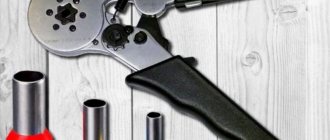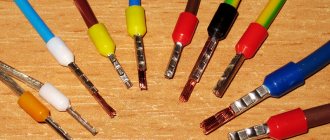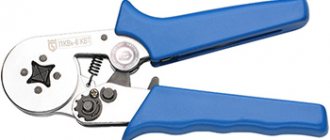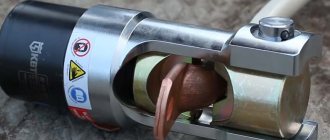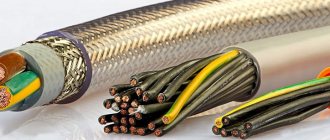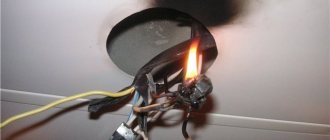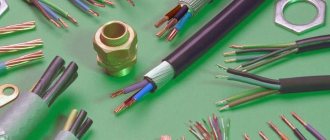Tinned lugs for crimping in accordance with GOST 7386-80 are intended for terminating copper wires and cables by crimping. Manufacturing material: electrical copper grade M2. Which tip is best to choose for a copper wire depends on what kind of wire is intended to be installed: single-core or stranded. TML lugs can be used for both single-core and flexible wires. Although, if a single-core copper wire is being installed, you still need to figure out whether the tip is needed at all!
Cable lugs for crimping 62 products
Cable lugs for crimping 62 Buy cable lugs for crimping in the Skala online store at low prices. Cable lugs for crimping are always in stock, a huge assortment, high-quality products, with delivery throughout Moscow, tel.: +7 (499) 170-10-10,.
- Tip TML 25-6-7 - tinned
Price:
34 rub.
Buy Compare
- Tip TML 95-12-16 - tinned
Price:
173 rub.
Buy Compare
- Tip TML 95-12-15 - tinned
Price:
144 rub.
Buy Compare
- Tip TML 95-10-15 - tinned
Price:
144 rub.
Buy Compare
- Tip TML 70-12-13 - tinned
Price:
81 rub.
Buy Compare
- Tip TML 70-10-13 - tinned
Price:
81 rub.
Buy Compare
- Tip TML 6-6 -4 tinned
Price:
11 rub.
Buy Compare
- Tip TML 6-5-4 - tinned
Price:
11 rub.
Buy Compare
- Tip TML 50-8-11 - tinned
Price:
70 rub.
Buy Compare
- Tip TML 50-12-11 - tinned
Price:
70 rub.
Buy Compare
- Tip TML 50-10-11 - tinned
Price:
70 rub.
Buy Compare
- Tip TML 4-6-3 - tinned
Price:
9 rub.
Buy Compare
- Tip TML 4-5-3 - tinned
Price:
9 rub.
Buy Compare
- Tip TML 35-8-9 - tinned
Price:
56 rub.
Buy Compare
- Tip TML 35-8-10 - tinned
Price:
64 rub.
Buy Compare
Products 1 - 15 of 62 Home | Prev. | 1
| Track. | End | All
Cable lugs are a universal element that is used in most electrical fields. It is especially suitable for domestic needs: electronics repair, electrical wiring, installation of electronic boards, etc. The product is also used in industrial, transport and other areas where cables are used to organize systems.
Installation of bolt tips - work order
1Select a lug according to the cable cross-section.
This can be done using the table:
2Strip the insulation at the end of the cable core.
To find out how many centimeters you need to cut, insert the core into the inside of the tip and add another 5 mm of margin.
3Use a wire brush to clean the exposed core until shiny.
After this, installation should be completed within 5 minutes. Otherwise, an oxide layer may form on the aluminum core. The surface is degreased and wiped with a clean rag.
4The core is placed inside the housing until it stops and the bolts are tightened manually.
5To ensure that the core does not deform or bend when tightening, the sleeve itself must be fixed.
This can be done with a special device from the KVT NMB-4 kit.
6Using a spanner or sockets, make a final tightening of the bolts until the top part comes off.
First of all, you need to rip off the screw head, which is located closer to the mounting hole. And then the rest.
When installing sleeves, use those that are closer to the middle.
Some people have a question: what if you don’t completely rip off the head and just tighten it tightly? Is it possible to subsequently remove such a tip and reuse it?
It is forbidden. If you did not break the bolt, then you did not provide the required compression force on the wire inside the sleeve. And accordingly, your contact will be poor.
And besides, the next time this bolt is tightened in a different place, its breaking torque may be completely different.
Table of shear moments (Nm) for tips and connectors with shear bolts from KVT:
Advantages of using a cable lug for crimping
You can also fix and connect cables by creating loops using twisting, but this method is far from perfect. When using it, it is impossible to obtain the optimal contact area, and individual veins become covered with oxides and break off. Using a cable lug avoids this problem and provides a number of benefits:
- Low connection resistance.
The element tightly compresses all cable cores and provides the highest contact area. As a result, the current passes through the area with minimal heat loss, without causing overheating and melting of the elements. - High strength.
When using a ferrule, there are no exposed areas without insulation on the cable. It is in these places that it most often cracks, unravels and breaks off. - No oxides.
The appearance of corrosion is one of the main reasons for poor conductivity and low strength. It again forms in open areas, which can be closed using the tip. - Easy to install.
Clamping and twisting a regular bare cable with a screw is problematic and ineffective. With a tip, everything is much simpler - just tighten the cable with a screw through the finished hole. - Possibility of disassembly.
The tip is easy to remove and install back in case of repair or replacement of system elements. The usual twisting will most likely have to be redone by cutting the cable.
Differences, types and characteristics
What other significant differences are there in bolt terminals and connectors, besides cross-section and operating stress?
Along with the standard (in-line), tips with angular placement of bolts are produced. Here are the technical characteristics of both.
NB terminals and SB connectors - dimensions, technical data:
NBSB
With angular arrangement of the NBE and SBE brands - technical parameters:
NBESBE
SBE
What are their differences and which ones are better?
Those where the bolts are located at an angle provide a much larger contact area, since in them the wire is pressed not only from top to bottom.
Accordingly, the strength of the connection itself is better. However, it is much more convenient to install tips with a row arrangement, especially in narrow and small spaces.
The mechanical strength and reliability of contact largely depends on the number of shear bolts. It is recommended to have one bolt only for specimens with a cross-section up to 25mm2.
For all other sections there must be at least two bolts on the tip, and four on the sleeves.
The rule works here: as the cross-section increases, the number of shear heads increases.
Tips up to 10kv and 35kv
As mentioned above, there are types up to 10 square meters and up to 35 square meters.
Technical characteristics for terminals and connectors up to 35 kV of the NBE-35 and SBE-35 brands:
NBESBE
There are many differences between the 35kv and 10kv types. For example, a hole for a cable core. In the case of specimens up to 10kV there is an eccentric hole.
And in housings up to 35 kW - centrally symmetrical.
Also, in models up to 35 kV, copper alloy is used for the production of bolts.
In addition, there is a hole for a hexagon in the head of the bolt.
Bolted ones up to 35 kV also have end chamfers. They help smooth out the electric field strength.
Depending on the cross-section, the design of the tip blade may change. So in specimens up to 300-400mm2 the blade is shifted from the central axis. This allows them to be connected in the middle of a switchgear bus without any problems.
But models from 500, 630 mm2 and above have a centrally symmetrical blade.
One of the new types of tips and connectors is the NBP and SBP brand. They are designed for XLPE cables. Their technical characteristics:
NBPSBP
Separately, it is worth noting the tinned models (they have the letter “L” in their markings). Such species have a higher resistance to chemically aggressive substances and adverse weather conditions. And during long-term storage or operation they are not subject to oxidation.
If you need to connect cores of different sections to each other, then for this you will need PSBE adapter connectors. Here are their sizes and data:
High-quality tips and sleeves must have a factory stamp on their surface, which indicates the range of their sections.
All of the above types are often immediately supplied with cable couplings. Naturally, they are designed for the same cross-sections as the cable sleeve.
Such couplings are mostly equipped with specimens with an in-line arrangement of bolts.
Classification of cable crimp lugs
Cable lugs for crimping can be divided into four main groups. Each has its own markings and features of use. The marking contains clear decoding rules. The first letter designates the workpiece (in this case, a tube), the second - the material, and the third - the coating. Then the cable cross-section and hole diameter in mm are sequentially indicated.
- TM - copper tip. Received the widest application due to the use of material similar to most cables. Widely used in all areas related to electronics.
- TA - aluminum tip. Most often used for crimping aluminum cables to avoid differences in chemical properties.
- TAL - tinned aluminum tip. It differs from the previous version in coating. In this case, you will not have to apply tinning yourself when using soldering for connections.
- TAM - aluminum-copper tip. Used in cases of connecting aluminum cables to copper busbars. The solution allows you to reduce resistance to a minimum.
Design
In addition, they are much more versatile than their counterparts for crimping. If they are designed only for one specific section, and an error in selection can subsequently lead to burnout of the contact, then bolted ones are suitable for several sizes at once.
For example, brand 2NB-70/120 stands for:
- NB - bolted end
- 2 - with two shear bolts
- 70/120 - for conductors with a cross section of 70mm2, 95mm2 and 120mm2 inclusive
The housings of the tips and connectors are not simply made of aluminum or copper, as in simple models. They are made from a special aluminum alloy. In addition to high electrical conductivity, it also has greater corrosion resistance.
If you look inside the case, you can see grooved knurling, as if someone had cut a thread. What is it for?
It is needed to increase the contact area and ensure mechanical strength of the contact.
These edges, when pressed on the aluminum core, seem to bite into the surface of the aluminum and destroy the oxide film.
There are several narrowed places or grooves on the bolts where failure occurs. Thanks to them, this very breakdown occurs below, or at the same level with the upper edge of the tip.
This way, there will be no need to grind or grind the rest of the screw or its edges.
But if the protruding part remains, what should you do with it? For specimens up to 10 kV, it is enough to grind off all sharp edges with a file. This is necessary so as not to damage the insulation of the heat shrink tube.
If the tube is thin-walled, it can be damaged due to this both during shrinkage itself and in the future during operation. However, be sure to clean off any metal filings from the surface before installing the tube HERE.
But at voltages of 20 and 35 kV, it is necessary to completely grind all protruding parts, regardless of whether they are sharp or not. Everything should be on the same level.
Otherwise, such “bumps” will significantly distort the electric field strength.
General information
Any good owner understands that simply connecting a household device to the network will not be enough to create acceptable conditions for operating the device. If the contact is poor, the wire will begin to experience overload when voltage is applied, which will most likely lead to failure of the entire device or even a fire in the wiring. To avoid such troubles, you need to make sure the connection is reliable. A TML tip is a special device that is designed to solve a specific problem. This is a special tip that is used to terminate an electrical wire and thereby ensure a reliable connection between the network and the device. There are several materials from which a tip can be made, but copper is considered the best.
Fixation options
One of the mounting options is bolted. In this case, the depth of fixation of the cable in the part will be fixed by the head of the bolt. Before connecting these two elements together, it is necessary to strip the required length of cable from the winding to expose the core. It is worth noting that the press can have different sizes, which depend on the area of application of the tool. However, the most popular recently have become those that can change their size, like an adjustable wrench. The change parameters range from 0.25 to 1 mm. There is another important detail here - there is no need to use pliers for work. The reason for this was that a hand press with this size is most often used for crimping very thin cables that can break under the strong pressure exerted on it by pliers.
Marking
The symbols for the tips are deciphered as follows: NShVI 1.5-8
H-tip
Sh-pin
B-sleeve
I-isolated
1.5 - for wire with a cross-section of 1.5 mm2
8 — the length of the uninsulated part of the tip is 8 mm. 8mm is the most common and most often used tip length with a cross section of up to 4mm2. Longer ones are needed for some special deep terminals.
Tips for two wires NSHVI (2) are used for making loops when you need to connect several circuit breakers mounted in one row.
To crimp these tips, a special tool is used - crimpers. The variety of types of crimpers is very large, from the cheapest to those costing about 200 euros.
Previously, when such a tool was not common, electricians crimped such tips with simple wire cutters. But still, for reliable contact and quality of work, you should crimp the tips only with a tool designed for this purpose.
Installing Items
There are 4 main ways to mount tips. The first option is crimping, the second is screw or bolt, the third is welding, the fourth is soldering of tips.
If we talk about this type of connection, such as crimping, it can be performed with four different tools. It can be a hand press, a mechanical press, a pump press or a hydraulic press. It is important to understand here that each of the devices has its own qualities and properties. For example, to press household wire and ferrules, it is best to use a regular hand press. In order to connect the power cable and the tip, you will have to use a more powerful tool. Most likely, you will need a hydraulic or mechanical press.
Tip with viewing window
One type of TML tip is the TML(o). In terms of basic characteristics, these models are completely identical. As follows from their markings, they are also made of copper, like the rest of the parts. The only important difference from standard elements was the presence of a viewing window. This is a hole that allows you to make sure that the contact is connected correctly while the device is already put on the wires. Most often, such varieties are used in industrial enterprises, and therefore not all electricians or just home owners who need to connect wires know about the existence of such a small subspecies.
Homemade tips
Currently, the most popular tips are PHOENIX CONTACT. They are in greatest demand in the CIS. Reviews about this product are most often positive. They stick to the cable quite well. The connection between the cable and this part is also at an acceptable level, according to buyers. Some of the buyers used this part to rebuild the electrical contacts of a car engine. The owners note that even without a crimper it is very convenient to do crimping. You can do it with a hammer, but you need to hit it carefully, otherwise you can break the veins. At a current of approximately 80 A, the contacts remained cold.
However, it is not always possible to find a suitable device. For this reason, quite often people make them themselves. This is quite easy to do. In order to make such an element, you need to take a copper piece of pipe with the appropriate size, flatten one end, and then make a hole with the required size. However, the problem may be that it is not clear what voltage such a product will be able to withstand. Therefore, it is not recommended to do them yourself.
Bimetal tip type
The type of TML cable lug may differ not only in the material from which it is made, but also in the method of its installation, as well as in its purpose.
The most universal part is considered to be an electrical bimetallic part. It has such advantages as the ability to connect to any type of metal conductor, and also has a special small stopper that allows you to clamp the wire at the required length. Most often, aluminum is used instead of copper to produce such devices.
Another type of this element is the TML KVT tip.


